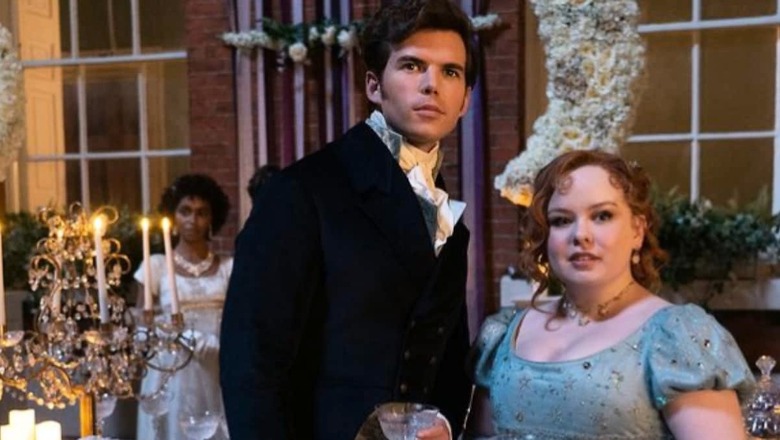
views
In its third outing, Bridgerton finally focuses on the romance between Penelope Featherington (Nicola Coughlan) and Colin Bridgerton (Luke Newton), a romance that Colin is the last to realise.
Colin Bridgerton is back from his summer travels and has received the patented ‘Bridgerton glow-up’. Although Colin is still our sensitive hero, now, he flirts with ease in parties, spends his evenings having threesomes in brothels and has become the most eligible bachelor in the marriage mart. This season, Colin has swagger.
Although, Colin’s swagger only lasts until his torrid passions take over and he realises he’s in love with his best friend. After years of slow roasting in the background, Penelope and Colin’s love story is ready to be devoured. These moments of yearning and desire make the ‘friends-to-lovers’ trope work. Although the yearning this time is not as seasoned. Colin’s is a case of long-simmering wait. There is no real challenge in his way (yet). Thus, much of what makes their romance so delectable is Penelope Featherington. For all the fuss made about the Bridgerton kids being the most eligible suitors in the town, this season belongs to Penelope.
Penelope has long been the most relatable character and the makers (Jess Brownell, Julia Quinn who’s books the series is based on, Chris Van Dusen, Shonda Rhimes and Tom Verica) have masterfully harnessed this relatability in season 3. To put it simply, Penelope is “just a girl”. She writes angry rants after meltdowns, thinks a wardrobe makeover will solve her problems and wants to kiss a boy she loves. This relatability has always made her stand out despite being a “wallflower”.
But, there is more to Bridgerton and Penelope than just the chemistry between the two lovers. What also stands out is the chemistry between Eloise (Claudia Jessie) and Penelope – a yearning to mend a friendship ruined when Eloise discovers Lady Whistedown’s identity. Theirs is a plot with more challenge, brimmed with chemistry. Neither seems to get the other off her mind. Eloise is most surprised by Penelope’s desire to find a suitor. She cannot take her eyes away from her former best friend when she debuts her new look. Eloise is the most affected when gossip is spread about Penelope.
Brigderton’s cast is its best asset considering that the show, although said to be set in regency-era London, is highly unanchored in time and space. Nicola Coughlan plays Penelope with such ease you’d think she leads a double life. Luke Newton perfectly compliments Nicola (on screen and off screen) and holds our attention with his gaze. Claudia Jessie is a delight as Eloise, a breather from the other debutants cut from the same cloth. Although Golda Rosheuvel’s Queen and Adjoa Andoh’s Lady Danbury didn’t get to banter much.
New cast member, Hannah Dodd, stands out as Francesca Bridgerton, the latest debutant in the marriage mart. Her desire to seek marriage as a means of freedom mirrors Penelope’s ideology and their heartfelt conversation was a nice way to link their stories. It was also interesting to spot Banita Sadhu as one of the debutants. Although Banita had a minor role, it was fun to see a familiar face in the show.
The first four episodes of the third season have been given too much responsibility to shoulder. Besides Penelope’s storyline with Colin and Eloise, we also get a peak behind Cressida Cowper’s (Jessica Madsen) armour. The season also builds up Benedict Bridgerton’s (Luke Thompson) forthcoming romance and hints at Lady Violet’s (Ruth Gemmell) second chance at love while she tries to secure a match for Francesca. These interspersed sub-plots sometimes feel too much and the show’s glossy smoothness hides any flaws, immediately shifting focus to the pastel-themed lives of our protagonists.
But for a second, let’s pause the regency talk and go further back in make-believe time. Once upon a time in ancient Greece, Eros was tasked to find a love match for Psyche. However, in trying to find a suitor for her, he ended up falling in love himself. Years later, in fictional regency-era London, Colin Bridgerton, who is supposed to help find a suitor for Penelope Featherington, falls in love with her and they dance on a floor with Eros and Psyche’s portrait.
Bridgerton relies on symbolism to make the story more nuanced. For example, Penelope’s symbol is the butterfly (also the symbol for Psyche) and she’s seen wearing butterfly accessories and clothes throughout the seasons. This time, even Colin had butterflies on his waistcoat. Moreover, when Penelope sheds her citrus hues and desire for Colin, she shines in emerald green (her entrance to Gayle’s ‘abcdfu’ is one of the highlights of the show). However, she finds herself still enamoured by Colin and slowly adopts the Bridgerton blue.
Bridgerton has used these symbols well in its favour over the seasons. However, in a fun and refreshing take, the show was more open about its ‘easter eggs’ this season. Jane Austen’s Emma – a heavy influence this season – and the myth of Eros and Psyche have all found their way into dialogues.
While talking about the Bridgerton lore, it is important to remember that this is only the first part of the third season. The show does not take itself too seriously and neither should we. While it felt like too many plots were fighting for attention, it will be interesting to see how they reach the crescendo in the later half of the season. That said, Bridgerton season 3 part 1 gave me a small slice of #Polin (very season 1-coded) and now I want more!














Comments
0 comment